Mastering Kheer: A Traditional Rice Pudding Recipe
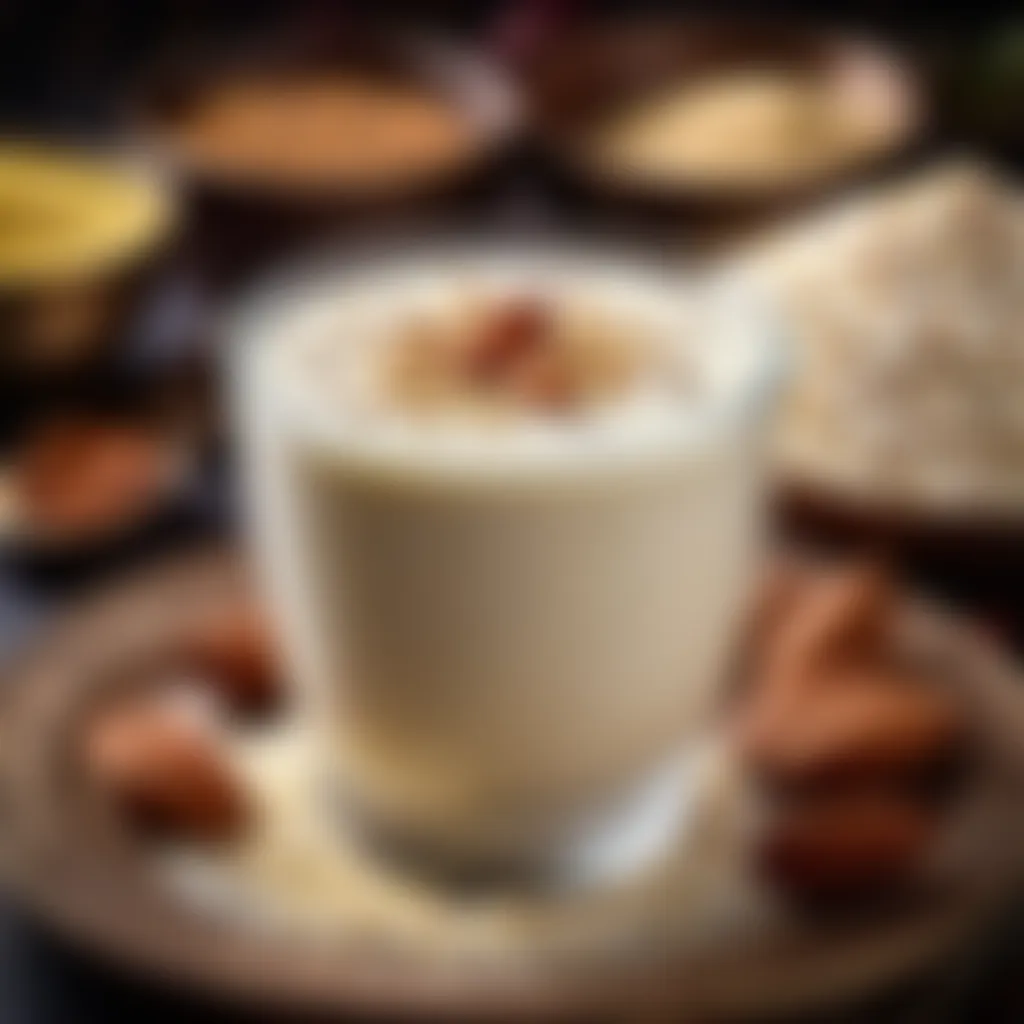
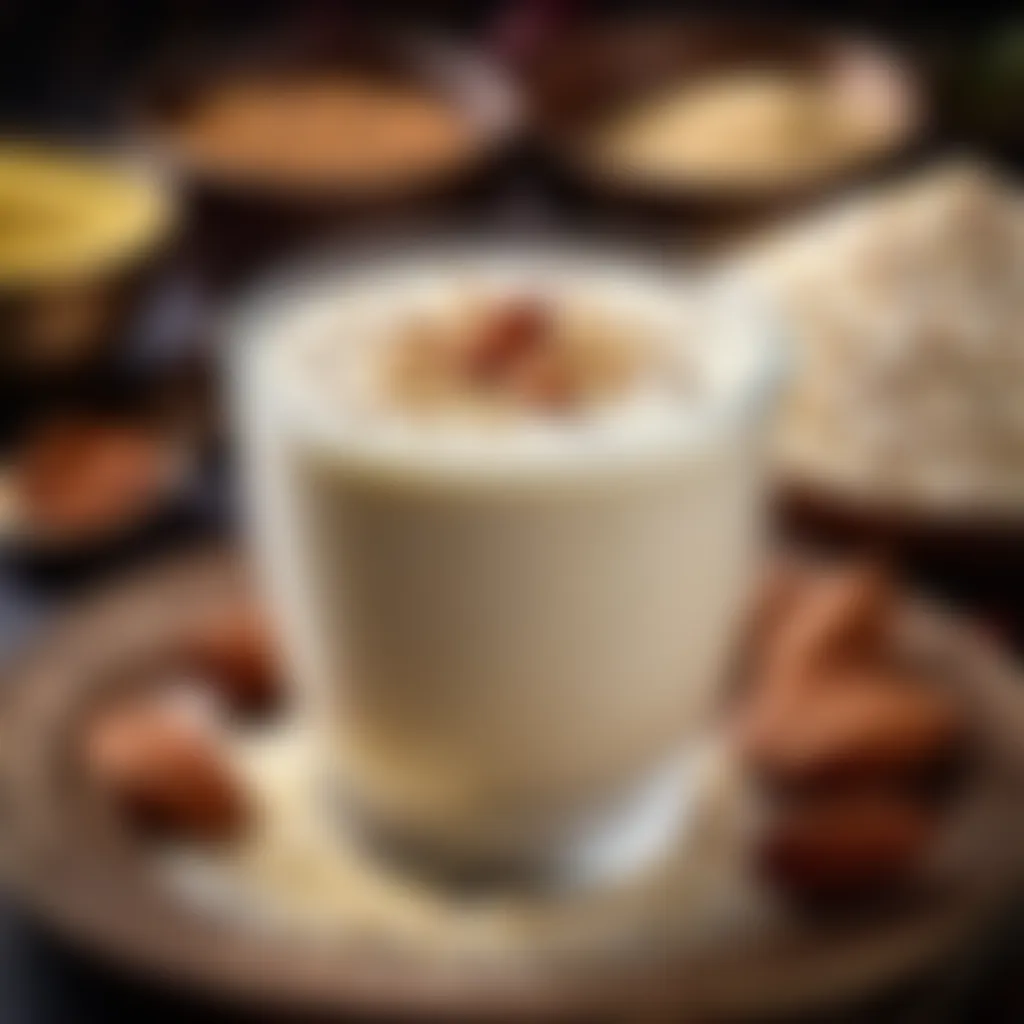
Intro
Kheer, a dessert that has found its way into the hearts and homes of many, transcends not just geographical borders but also generations. Often associated with celebrations, family gatherings, and festive occasions, this delightful rice pudding is more than just a sweet treat; it embodies love, tradition, and artistry in its preparation. In this comprehensive guide, we’ll take you through the essentials of crafting kheer, from the foundational ingredients to the nuanced techniques that elevate this dish from ordinary to extraordinary.
Delving into its roots, kheer has origins steeped in the culinary history of India, but variations can be found throughout South Asia. Whether in the form of the creamy rice pudding you savor during festivals or as a comforting dessert after a hearty meal, the variations are endless.
To ensure a rewarding cooking experience, let’s start with the very cornerstone of kheer: its ingredients.
Understanding Kheer
Kheer, often referred to as a sweet rice pudding, is a rich, creamy delicacy that has found its way into hearts and homes across numerous cultures. The beauty of kheer lies not just in its taste but in the stories, traditions, and emotions woven into its making. By taking a closer look at kheer, one can appreciate its various forms and understand its significance in both everyday life and festive occasions.
Definition and Overview
Kheer, a traditional dessert made mainly from rice, milk, and sugar, boasts a velvety texture that melts in your mouth. It’s a dish that transcends regional boundaries, taking on unique flavors and ingredients depending on where it's made. In essence, kheer is not just a dessert; it's an experience.
The base ingredients of kheer, comprising rice and milk, are usually enhanced by various flavors, such as cardamom, saffron, and nuts. The dish can be served warm or chilled, which is particularly refreshing during hot weather.
Cultural Significance
Kheer occupies a special place in many cultural festivities. In various Indian households, it often forms part of numerous rituals, religious ceremonies, and celebrations. For example, during festivals like Diwali or Eid, serving kheer can symbolize prosperity and joy.
Furthermore, kheer also brings together families. The preparation can be a communal effort, with family members gathering not just to cook but to bond over the process, sharing stories and laughter. It serves as a reminder of the warmth and love that goes into creating something delicious.
Historical Background
The origins of kheer can be traced back several centuries, with references found in ancient texts. Some believe it dates to the Vedic period, while others attribute its evolution to Mughal cuisine, which introduced richer flavors and ingredients.
Historically, different regions have their distinctive methods and presentations of kheer. For instance, the North Indian version might be richer and creamier, while South Indian styles offer unique touches like coconut or jaggery. The evolution of kheer reflects the blending of cultures and flavors over time, making it a true culinary treasure.
"Kheer is not merely a dish; it's a confluence of culture, history, and personal bond."
In summary, understanding kheer goes beyond recognizing it as a mere dessert. It encapsulates a tradition that has evolved while remaining rooted in its base ingredients and preparation methods. Holistically, kheer serves as a vehicle for nostalgia, celebration, and communal harmony.
Essential Ingredients
Understanding the essential ingredients in making kheer is foundational to crafting this delightful rice pudding. Each component plays a vital role in the development of flavor, texture, and nutritional value. By carefully selecting quality ingredients, you can elevate your kheer from simple to sublime. Here, we will explore the critical elements that come together to create this beloved dessert.
Types of Rice
In the realm of kheer, the type of rice you choose is pivotal. The traditional choices often include Basmati, which is cherished for its long grains and aromatic qualities, and short-grain rice varieties like Sona Masoori or even Arborio.
- Basmati Rice: Renowned for its fragrance, Basmati rice offers a delicate nuttiness that complements the sweetness of kheer. Its long grains fluff up beautifully during cooking, making for a pleasing presentation.
- Sona Masoori: This medium-grain rice is a popular option for kheer, especially in Southern India. It's known for its slightly sticky texture, providing a heartier kheer that feels fulfilling.
- Arborio: Typically used for risotto, Arborio rice can also be a unique twist in kheer preparation. Its starch content lends a creamy consistency that's simply delightful.
When selecting rice, it's vital to rinse it until the water runs clear. This step removes excess starch and prevents the kheer from becoming overly sticky.
Dairy Choices
Kheer wouldn't be kheer without its creamy dairy base. The most common choice is whole milk, but variations abound depending on regional traditions.
- Whole Milk: The gold standard for a rich and creamy kheer, whole milk provides the luxurious mouthfeel that many seek. Its fat content leads to an indulgent experience.
- Condensed Milk: For those pressed for time, condensed milk offers sweetness and a distinctly creamy texture. It can cut the cooking time in half, yielding quick but satisfying results.
- Coconut Milk: This option brings a tropical twist to kheer, featuring a subtle sweetness and a unique aroma. It's particularly popular in various South Asian regions.
A tip is to always boil the milk, then simmer it gently. This practice allows the milk to reduce, concentrating the flavors further.
Sweeteners
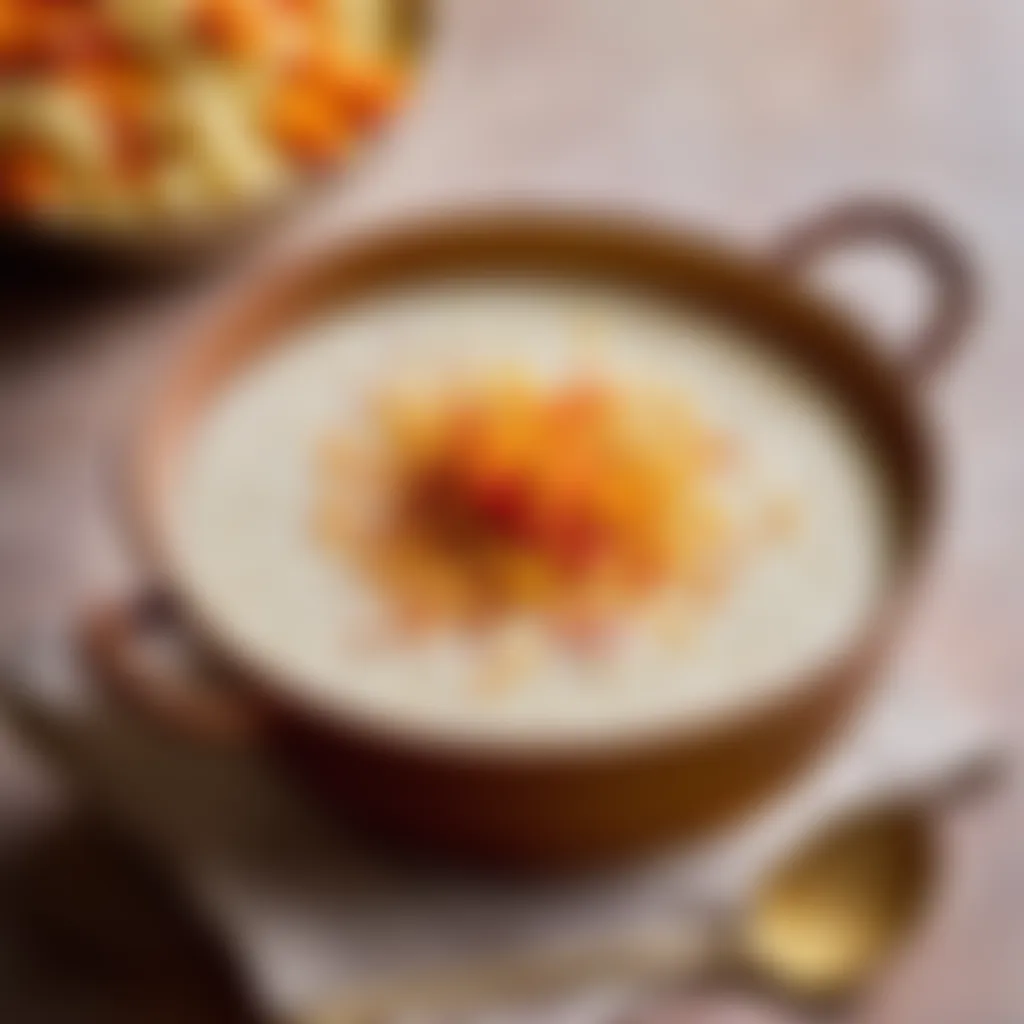

Sweetening your kheer is where creativity can truly shine. While sugar remains the tried-and-true choice for many, there are other fascinating options to explore.
- Sugar: Traditional white sugar is a common sweetener, but do consider its alternatives. Brown sugar can add depth and a slight caramel flavor.
- Jaggery: Known for its rustic flavor and nutritional benefits, jaggery is a traditional sweetener in South Asian cuisines. It adds richness and a hint of molasses. Remember, jaggery should be added towards the end of cooking to prevent burning.
- Natural Sweeteners: Honey or maple syrup can provide a distinct taste while being less processed. However, they should be added after cooking to preserve their health benefits.
Be mindful of the quantity; you don’t want to overshadow the delicate flavors of the rice and milk with too much sweetness.
Flavor Enhancements
To create a kheer that stands out, flavor enhancements are vital. Spices and garnishes help create layers of taste, making each bite more enchanting.
- Cardamom: Often known as the queen of spices, cardamom brings aromatic warmth. Ground or whole pods can be added, depending on your preference.
- Saffron: Just a pinch of this luxurious spice can elevate your kheer to royal status. Infuse it in warm milk before adding it to the pot for maximum flavor.
- Nutmeg: A sprinkle of nutmeg adds a subtle earthiness, but be careful — it can easily dominate the dish if overused.
- Garnishing: Chopped nuts like almonds, pistachios, and cashews can provide delightful crunch and visual appeal. Raisins and dried fruits can also infuse sweetness and texture.
Each enhancement should be chosen thoughtfully, matching the final taste profile you wish to achieve — whether it be delicate and fragrant or rich and indulgent.
"The secret to a remarkable kheer lies not just in the process but also in the careful selection of ingredients and flavors that resonate personally."
In sum, these essential ingredients create the foundation of kheer. When armed with quality choices and a bit of creativity, you can craft a dessert that tells a delicious story. Whether you're aiming for a traditional take or a modern twist, the right ingredients will always lead you to success.
Preparation Techniques
When it comes to making kheer, the preparation techniques can either make or break the dish. Getting these processes down to a fine art not only ensures that the kheer turns out well but also enhances the overall flavor and texture. Understanding and implementing the correct methods creates a pudding that’s rich, creamy, and thoroughly delicious. With various stages of preparation in kheer-making, each step requires attention and care. This section dives into the pivotal techniques that define kheer preparation.
Selecting the Right Rice
The journey of creating the perfect kheer begins with the rice. It's critical to choose the right type, as it fundamentally affects the pudding's final texture. Typically, short-grain rice like Basmati or Gulab is favored for its ability to absorb liquid well and release starch, which leads to a creamy consistency.
- Basmati Rice: Renowned for its fragrance and length, it yields a luscious kheer when cooked right.
- Gulab Rice: A common choice that's slightly sticky, making it ideal for holding flavors.
As a tip, avoid long-grain rice varieties since they don’t have the same ability to thicken the pudding due to lower starch content. Choosing rice with high starch content makes all the difference.
Soaking the Rice
Soaking the rice before cooking might seem like an unnecessary step, but it’s like giving your grains a jump-start. This not only softens the grains, making them easier to cook evenly, but also helps in achieving that coveted creamy texture.
- Duration: Aim for 30 minutes of soaking. Longer isn’t always better; it can make the rice overly mushy.
- Water: Ensure the water is clean and fresh. It can also be slightly warm, aiding the grains in absorbing moisture faster.
A little patience here pays off significantly in the final product.
Cooking the Rice
Now that the rice is prepped, the cooking method is vital. A common way is to cook it in water first until it’s partially done before adding the milk. The trick is to not cook it fully in water; leave some room for it to absorb the flavors from the milk later.
- Rinse the Rice - Rinsing removes excess starch and ensures the kheer won't end up gummy.
- Simmering - Use low heat to allow the rice to cook slowly, absorbing all the flavors.
- Milk Addition - As the rice begins to soften and swell, slowly introduce full-fat milk. It enriches the dish, making it velvety.
Cooking time is something to be mindful of. It can vary based on the rice's age and variety, but a general range of 20 to 30 minutes will suffice.
Adding Dairy and Sweeteners
Sweetening the deal, literally, requires careful consideration. Traditional kheer often uses sugar, but alternate sweeteners can offer unique flavors. You might consider jaggery for a earthier tone, or condensed milk for a rich sweetness.
- Milk Variations: Whole milk is typically used, but adding some cream can up the game with richness.
- Gradual Sweetening: Start by adding sweetener in small increments. This gives you greater control over the sweetness level, tailoring it to your family’s preferences.
It’s essential that these ingredients meld together; adding them too quickly can disrupt the cooking process.
Achieving the Perfect Consistency
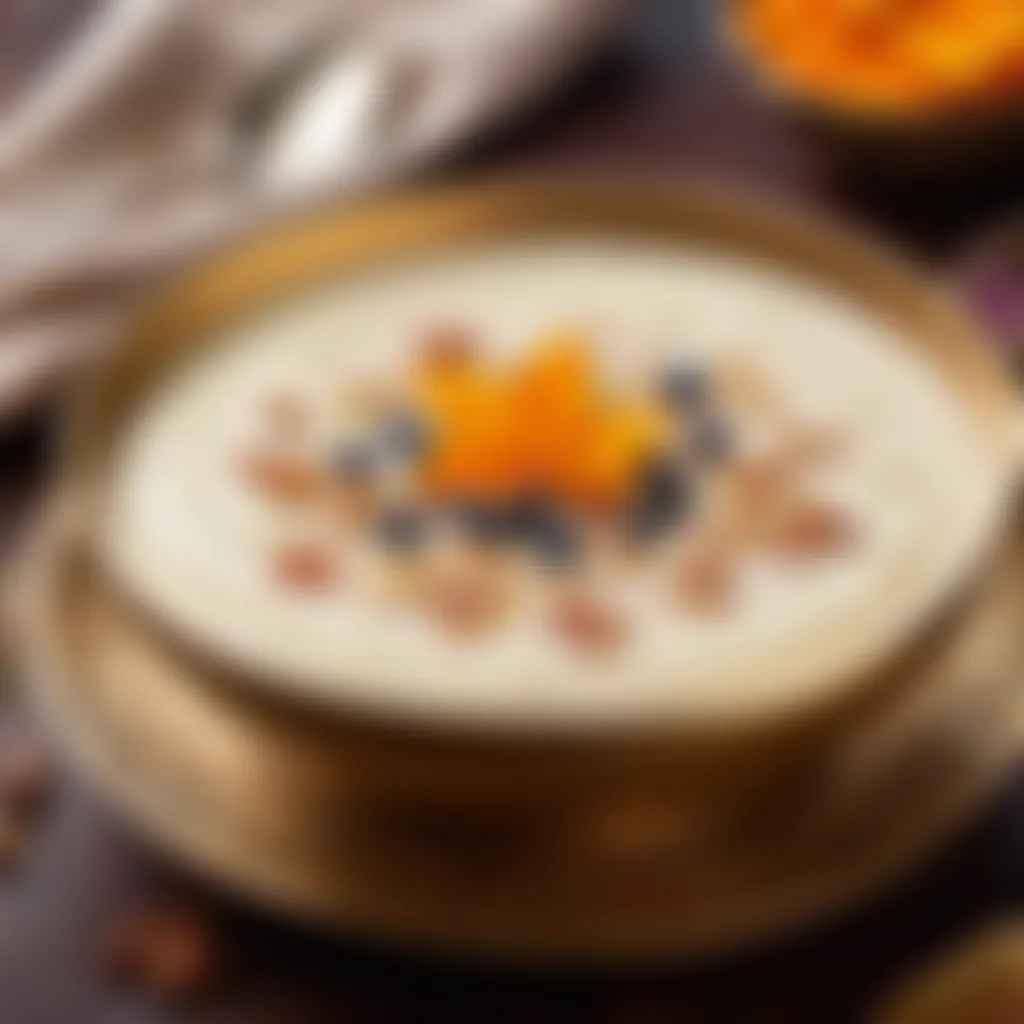

Consistency is the crowning jewel of any kheer. It should be creamy, but not overly runny or too thick. To get it just right is all about watching the cooking process closely.
- Visual Cues: Look for a pudding-like appearance it should flow smoothly when tilted but hold a defined shape in the bowl.
- Final Stirring: As you near completion, stir consistently, scraping the bottom of the pot as you do so. This incorporates all ingredients and prevents sticking.
Finishing touches like simmering for a few extra minutes can help achieve that beautifully thick consistency without overcooking the rice.
Important Note: Flavor and consistency can be judged by habit, but don't hesitate to taste during the process. Adjust as necessary, it’s all part of mastering this dessert!
In wrapping up this section, mastering these preparation techniques is crucial. They not only enhance the quality of kheer but also serve as a canvas for your creative expressions in the kitchen.
Common Variations of Kheer
Kheer is a canvas of taste and culture, and its common variations reflect the rich culinary palette from which it springs. Each spin on this classic dessert brings forth unique elements of flavor, texture, and presentation, allowing one to explore an extensive gastronomic landscape. These variations not only showcase personal preferences but also highlight regional customs and seasonal ingredients. Understanding these differences not only enhances one’s experience but also fosters creativity and exploration in the kitchen.
Nuts and Fruits
The addition of nuts and fruits is a well-loved way to elevate kheer. Think about the crunch of cashews or the sweetness of raisins adding texture and depth. Each nut or fruit can significantly change the pudding’s flavor profile, making them essential to this dish. Common choices include:
- Almonds: Sliced or slivered, they add a buttery crunch.
- Pistachios: They bring a slight earthiness and vibrant color.
- Raisins: Sweet and chewy, they balance the creaminess of the pudding well.
- Mango: Fresh or dried, they provide a tropical burst of sweetness.
In many cultures, nuts and fruits are also considered symbols of prosperity and health, thus enhancing the dessert's appeal during celebrations and festivals. Not to be overlooked is the texture they add, making every bite a delightful experience.
Flavoring Options
Flavoring your kheer doesn’t stop at the basics of sugar and milk. Various spices and flavorings can be introduced for distinctive tastes. Here are some popular options:
- Cardamom: Ground cardamom lends a warm, aromatic quality.
- Saffron: This expensive spice not only adds flavor but also a beautiful golden hue. Just a pinch infuses the pudding with luxury.
- Coconut: Using coconut milk or grated fresh coconut offers a tropical shift, perfect for summer days.
These ingredients can transform a standard kheer into something extraordinary. With each flavor added, the anticipation builds, promising a dessert that surprises and delights.
Regional Differences
Kheer's regional variations are a testament to India's rich tapestry of cultures. Each area has its own take on this delicious pudding, influenced by local ingredients and traditions. Some notable ones include:
- Paal Payasam (South India): Made with a rice variety called "pathiri rice," this version might use coconut milk, making it richer and more aromatic.
- Firni (North India): Here, ground rice thickens the pudding, resulting in a creamy texture, often served in small earthenware dishes.
- Pitha Kheer (Northeast India): This variation incorporates rice cakes or dumplings, adorned with traditional toppings, making it unique in texture and flavor.
Each of these styles tells a story of its origin, suggesting historical influences and cultural practices that enrich the experience of savoring kheer.
Through understanding these common variations of kheer, one can glean the depths of this seemingly simple dessert. It's a reminder to embrace change and creativity in cooking, bringing new flavors to life while cherishing the old.
Serving and Presentation
When it comes to kheer, the experience doesn't end at cooking. Serving and presentation play just as vital a role in elevating this humble rice pudding to a treasured dessert. How you present kheer can turn a simple dish into a showstopper, whether it's for a family gathering, a festive celebration, or a quiet evening at home. Let's explore the significance of temperature, garnishing techniques, and traditional serving dishes that can enhance your kheer experience.
Serving Temperature
The temperature at which you serve kheer can dramatically affect its taste and texture. Kheer can be enjoyed both warm and chilled, and each option offers a unique sensory experience.
- Warm Kheer: Served straight from the stove, it's often comforting, evoking nostalgic memories of home cooking. The warm, creamy texture envelops your palate, making it a perfect option for colder months or rainy days.
- Chilled Kheer: After chilling in the fridge, kheer becomes refreshing and cool, ideal for hot summer afternoons. The flavors can meld together beautifully during this waiting period, making every spoonful more delightful.
It's advisable to find a balance that suits your preference or the occasion. If you serve kheer warm, consider letting it cool for a short while—nobody wants to scald their tongue. Likewise, if you prefer it cold, a few hours in the refrigerator will make all the difference.
Garnishing Techniques
Once you've mastered the basic preparation of kheer, the garnishing techniques can turn it into an artistic creation. Here are a few ideas for garnishing that can add flair:
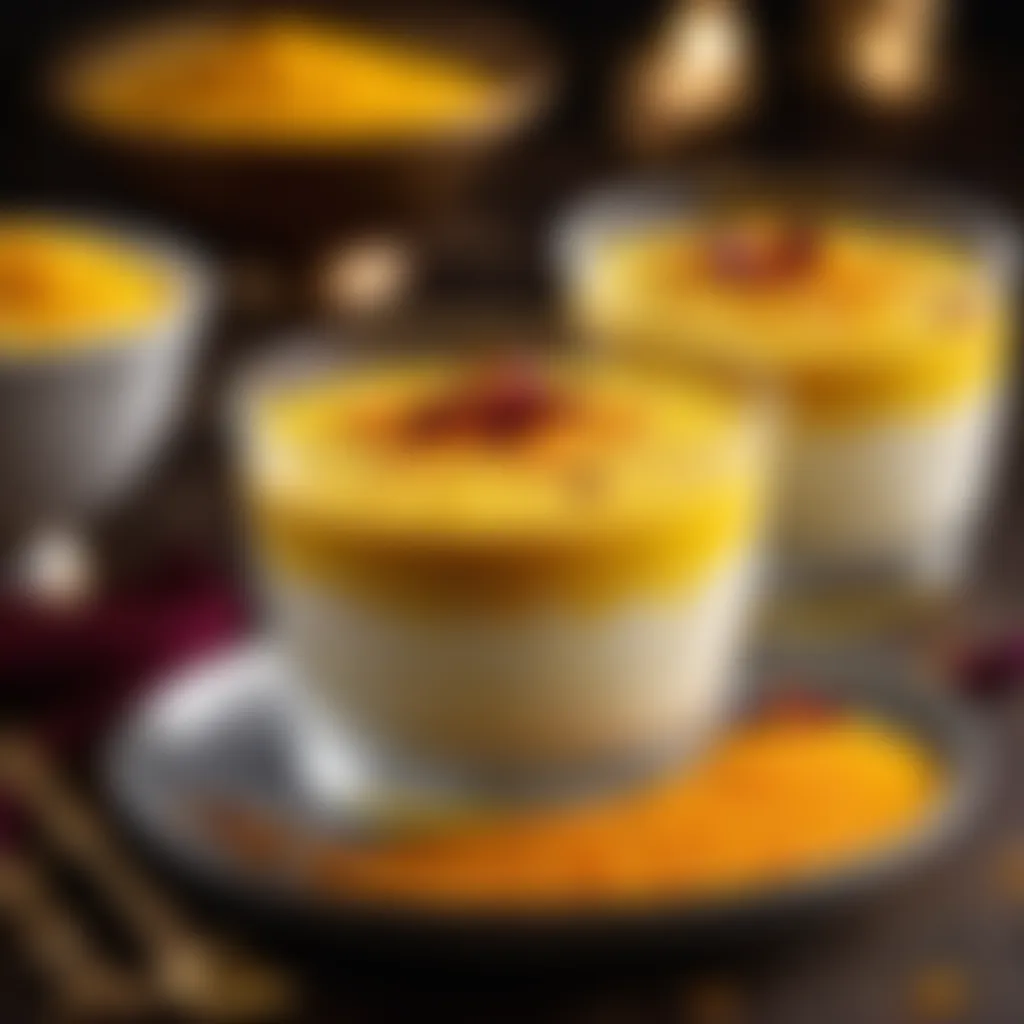

- Nuts: Chopped almonds, pistachios, or cashews sprinkled on top add a crunch. Toast them lightly for an added depth of flavor.
- Fruits: Fresh mango slices, pomegranate seeds, or shredded coconut can offer a contrasting texture and bright color, making your dish visually appealing.
- Saffron and Cardamom: A few strands of saffron and a light dusting of cardamom can give kheer a luxurious touch. These not only enhance the aroma but also an elegant appearance.
- Cherries or Berries: A pop of color can be created with cherries, strawberries, or any berry of your choice. A few scattered on top can transform the dish and make it more inviting.
Ultimately, it’s not just about taste; garnishing adds a personal touch that can speak volumes about your culinary creativity.
Traditional Serving Dishes
Kheer deserves to be served in a manner that reflects both tradition and care. Consider using the following types of dishes:
- Clay Bowls: Often used in Indian households, clay bowls can enhance the authenticity of the experience. They often contribute a unique earthy flavor that pairs beautifully with the creamy kheer.
- Decorative Ceramic Dishes: Beautifully designed, these can add elegance to your table. Choose ones with patterns that resonate with your personal style and the theme of the meal.
- Metal Bowls: Silver or stainless steel bowls can reflect cultural heritage and add a sense of importance to the occasion.
It's noteworthy that the way you serve kheer can reflect your approach to cooking—rooted in tradition yet open to personal embellishments.
"The best dishes are not only about flavor; they are a feast for the eyes as well."
In the end, serving and presentation transform kheer from nourishing food into an experience that can be savored in every sense of the word. The right temperature, garnishing, and dish selection can create a moment where your guests not only taste your kheer but feel the love that went into making it.
Health Aspects of Kheer
Kheer, while being a sumptuous treat, also carries a range of health aspects that aren’t always front and center in conversations about desserts. Delving into kheer's health benefits reveals not just indulgence but also nourishment, making it a delightful addition to anyone's culinary repertoire. In this section, we will explore the nutritional content and dietary considerations that can make kheer a healthful choice in moderation.
Nutritional Value
Kheer is primarily crafted from rice, milk, and sugar, but its true nutritional profile is multi-faceted depending on the variations and ingredients used. Understanding these nutritional elements helps in appreciating not just the taste but also the benefits.
- Carbohydrates: The rice and sugars in kheer provide a good source of energy. Carbohydrates, while sometimes seen in a negative light, are essential for the body's functioning, especially when consumed in moderation.
- Proteins: The milk adds a significant amount of protein to this dessert, aiding in muscle repair and growth. Additionally, the fermentation process, often used in certain kheer preparations, can enhance amino acid profiles, making protein more accessible for the body.
- Vitamins and Minerals: Depending on added ingredients like nuts or dried fruits, kheer can be enriched with vitamins and minerals. Nuts, such as almonds or pistachios, contribute healthy fats, vitamin E, and magnesium. Fruits can also add vitamin C and dietary fiber, beneficial for digestion.
- Antioxidants: Some recipes incorporate spices like cardamom or saffron, both known for their antioxidant properties. Antioxidants help combat oxidative stress in the body, contributing to overall health.
"A bowl of kheer does wonder not just for the taste buds but also provides essential nutrients, making dessert time guilt-free!"
Dietary Considerations
While kheer can certainly be delightful and provide nutrition, it's also essential for individuals to consider how it fits into their overall dietary needs. Here are some points to ponder when enjoying kheer:
- Caloric Intake: Given its rich ingredients, portion control is important. A large serving can really add up in terms of calories. For those mindful of their weight, enjoying a small bowl of kheer can satisfy sweet cravings without overwhelming the diet.
- Lactose Intolerance: For individuals who are lactose intolerant, traditional kheer can pose challenges. Alternatives such as almond milk or coconut milk can be used to create variations that are just as delicious but easier on the digestive system.
- Sugar Alternatives: Using alternatives like jaggery or honey instead of refined sugar can enhance the healthfulness of kheer. These natural sweeteners come with additional nutrients and have a lower glycemic index, making them a better option for those watching their sugar levels.
- Gluten-Free: Kheer is naturally gluten-free, appealing for those on a gluten-free diet, as long as the other ingredients remain clear of gluten contamination.
When it comes to kheer, it’s not just a treat for festivals or special occasions; when prepared thoughtfully, it can fit well into a balanced diet, celebrating the art of indulgence and nutrition.
Culmination
The conclusion of this article serves as a poignant reflection on the delicate craft of making kheer, a beloved rice pudding that reflects the essence of culinary traditions. Preparing kheer is not just about following a recipe; it is about connecting with history and culture, bringing families together through shared dishes in festive and quiet moments alike.
In the previous sections, we've explored the intricate details of kheer, from understanding its profound cultural significance to selecting the finest ingredients and mastering the various cooking techniques. Each step is paramount, as it contributes to the overall texture, flavor, and experience of the dish. Acknowledging the nutritional benefits also underscores kheer's role in our culinary landscape; it can be both a treat and a wholesome addition to your diet considering careful ingredient choices.
Ultimately, this article encourages understanding and appreciation of kheer not just as a mere dessert but as a keystone of cultural heritage. It signifies love in its preparation and brings warmth when shared, making it an essential addition to kitchens around the world.
"Cooking is an expression of the love and culture behind every dish, especially one as rich as kheer."
Reflecting on the Craft of Kheer
Reflecting on the craft of kheer is like examining a tapestry woven with stories, traditions, and flavors. Each cook brings a personal touch to kheer, influenced by their upbringing, environment, and the ingredients at hand. Whether you're using basmati rice or experimenting with different dairy options, each choice shapes the final product.
Kheer represents the fusion of art and science in cooking. The process requires patience—allowing the rice to absorb the milk, achieving the perfect creaminess without rushing. As with any craft, repetition leads to mastery, and kheer is no exception. Trying out different variations, be it the type of nuts you mix in or the different sweetness levels, allows one to redefine this classic dessert every time.
When you prepare kheer, you engage with your roots while also setting the stage for new family traditions. Whether it’s a festival feast or a weekend dessert, kheer invites you to appreciate not just the final dish, but the journey to create it.
Encouragement to Experiment
Beyond the traditional methods discussed, cooking kheer should be seen as a launching pad for creativity. Don’t feel bound by conventional recipes—let your imagination go wild! The beauty of making kheer is in its adaptability. Have some mango puree lying around? Slather it into your kheer for a tropical twist. Or perhaps infuse saffron for that royal touch. The options are nearly limitless.
Try out various nuts beyond the common almonds and pistachios. Cashews can provide a unique flavor, while coconut can add a delightful texture. If you’re feeling brave, even substitute rice with millets or quinoa for a health-conscious version.
Every tiny adjustment can lead to surprising outcomes. You might stumble upon a combination that resonates with your family’s palate, making kheer not just a dish, but a personal legacy. Let the kitchen be your laboratory, where each experiment adds another layer to the rich tapestry of kheer making.
In summary, the key to mastering kheer is embracing both tradition and personal modification. Step into the kitchen, gather your loved ones, and let the aroma of simmering rice and milk fill your home with warmth. Your journey into the world of kheer awaits.







